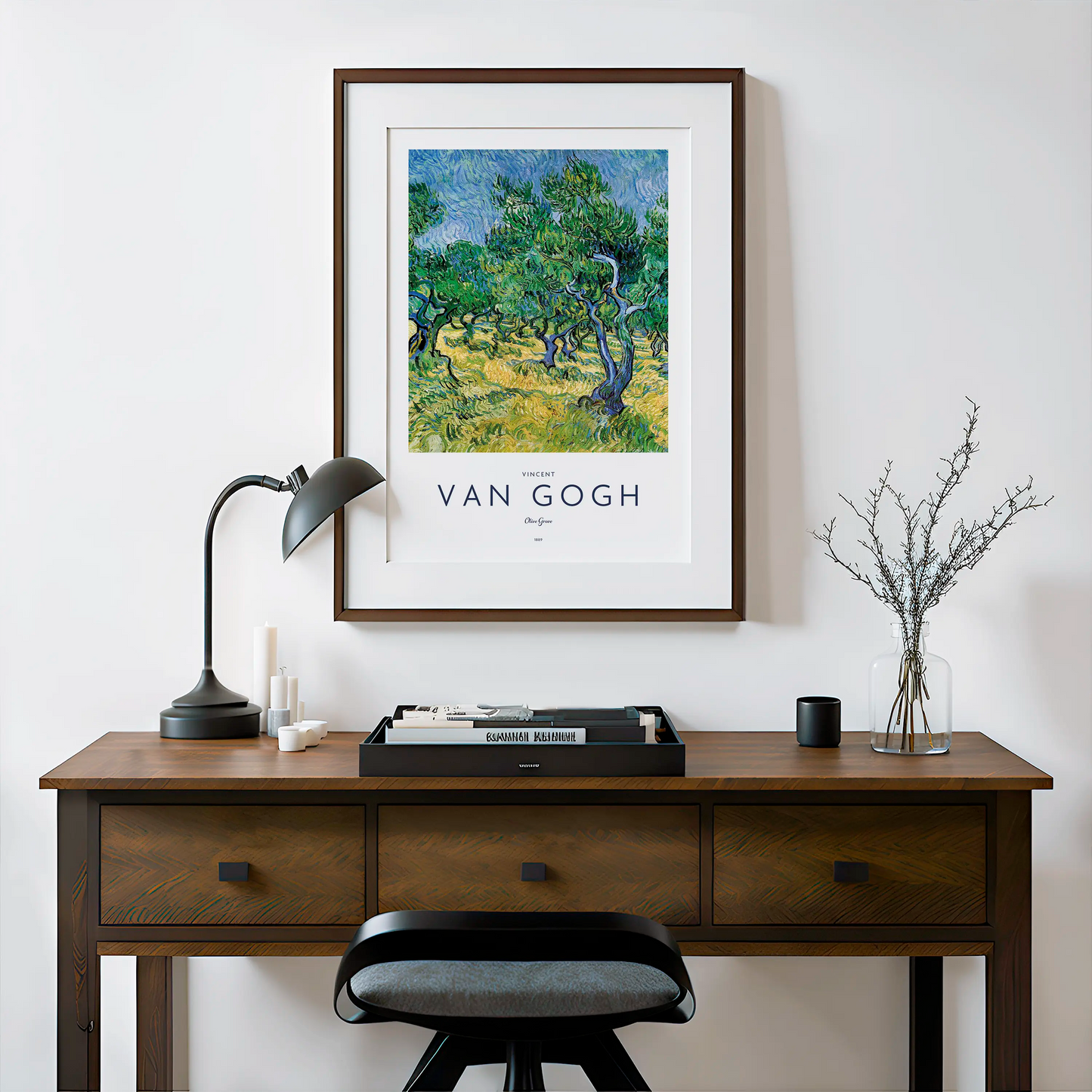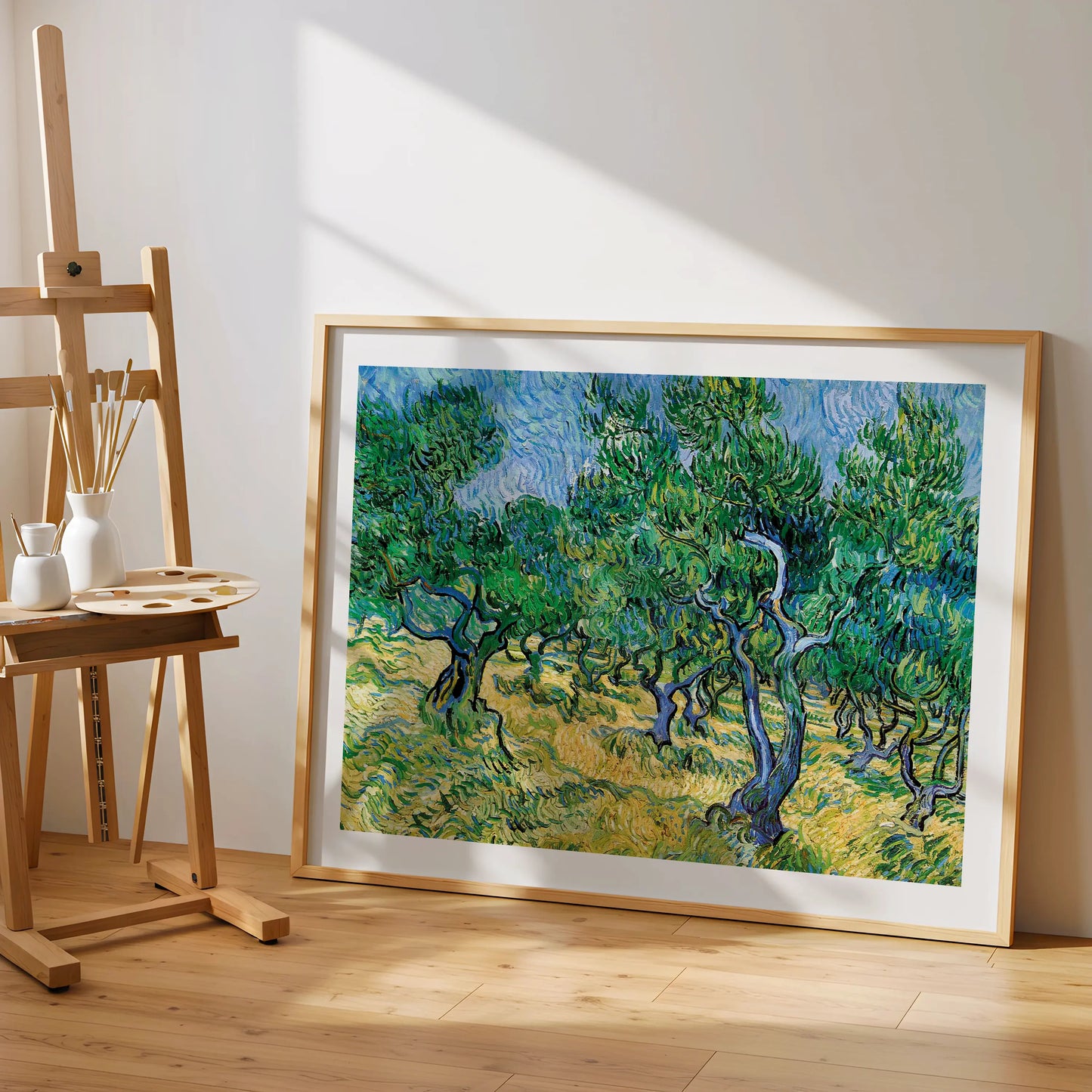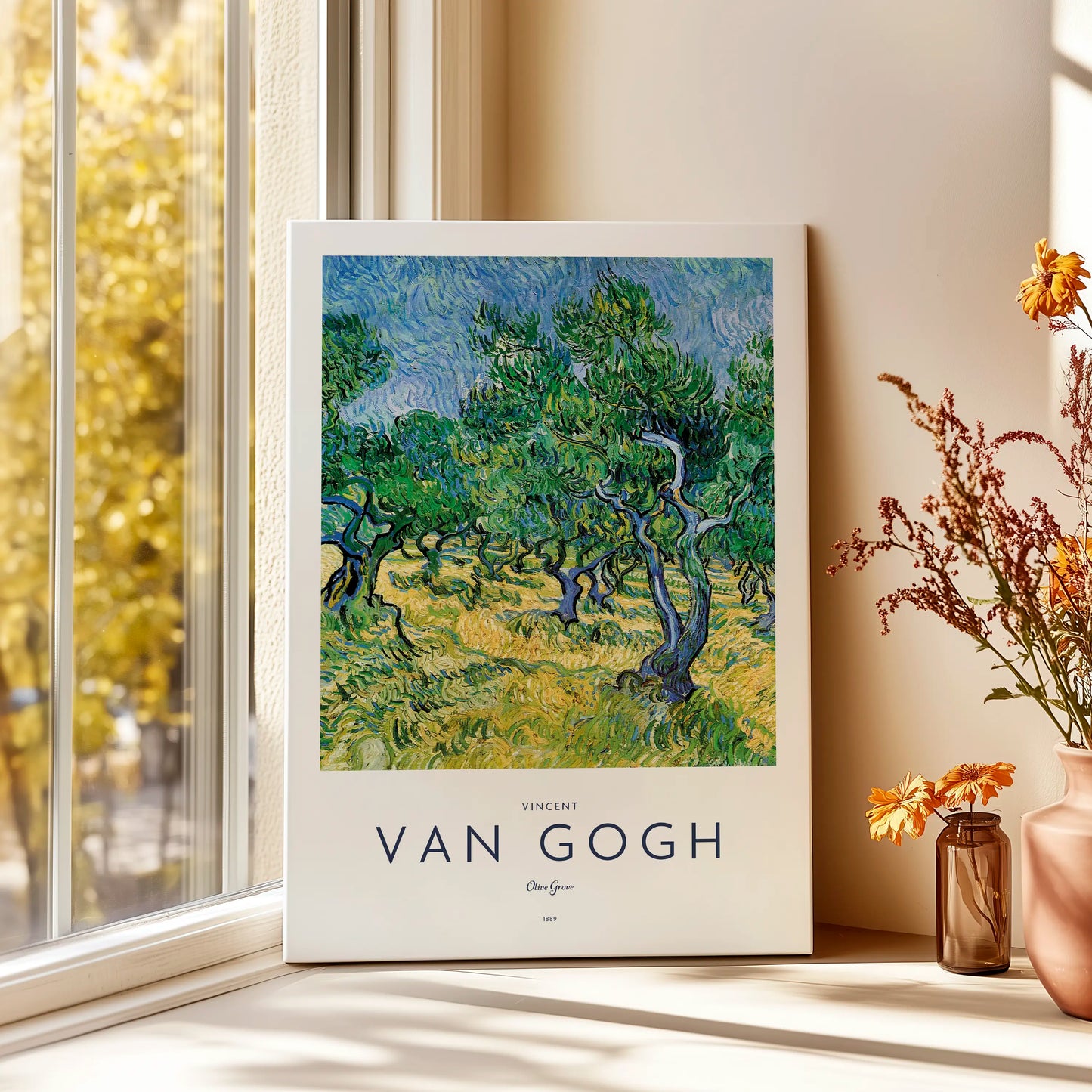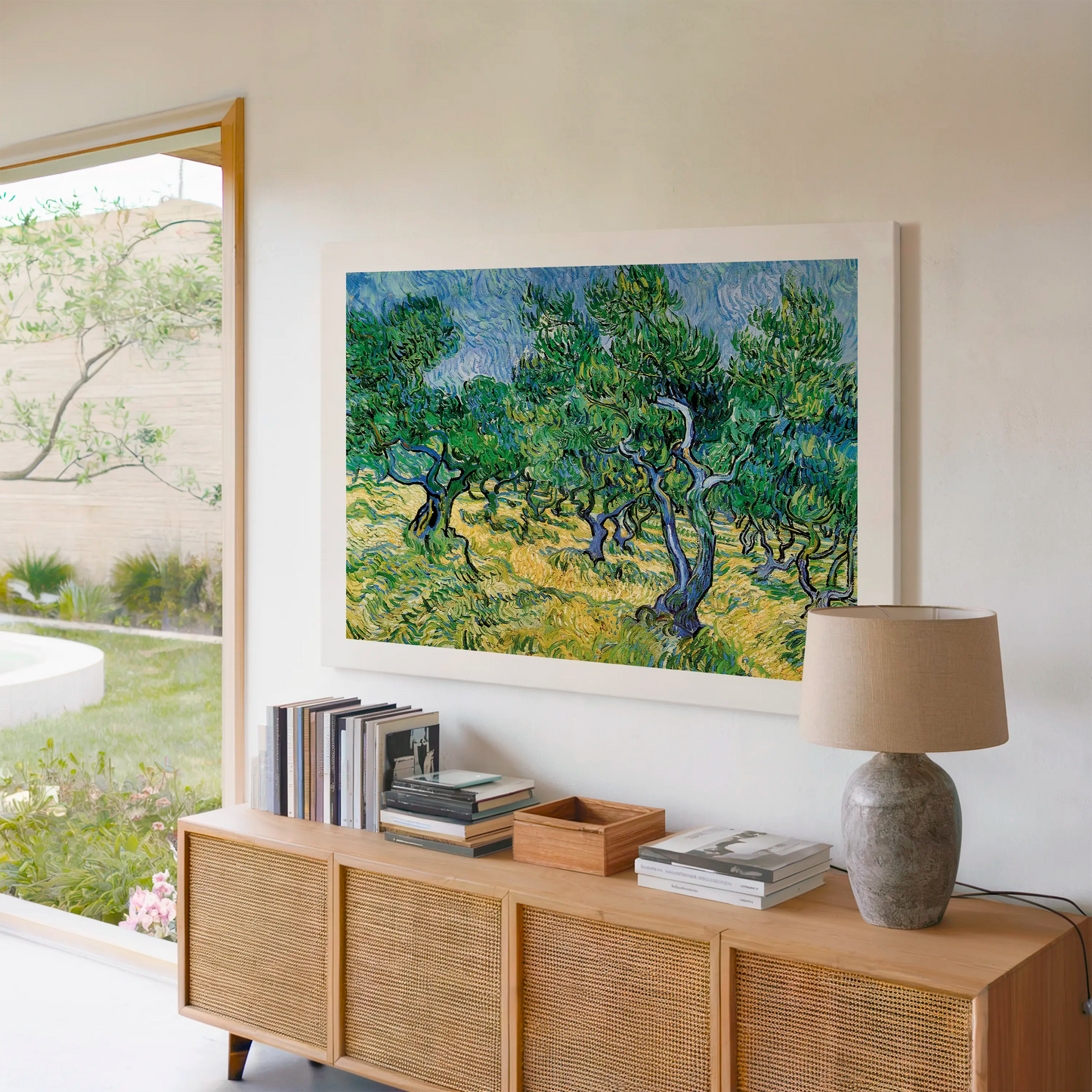Vincent van Gogh - Olive Grove (1889) - Digital File N210
Vincent van Gogh - Olive Grove (1889) - Digital File N210
Couldn't load pickup availability
Share
Paper Poster | Canvas Print | Digital File
1. Historical and Artistic Context
In 1889, while residing at the asylum of Saint-Paul-de-Mausole in Saint-Rémy-de-Provence, Vincent van Gogh turned to the surrounding landscapes as his primary subjects. Among these, olive groves held particular importance. The trees, deeply rooted in Mediterranean culture and biblical symbolism, captivated him. This period was marked by personal struggle yet immense productivity, as Van Gogh produced some of his most iconic works, including The Starry Night and Irises. The olive trees became symbols not only of the Provençal landscape but also of his search for spiritual meaning and emotional solace during confinement.
2. Technical and Stylistic Analysis
Van Gogh’s Olive Grove paintings are distinguished by bold, dynamic brushstrokes and an expressive palette. He used vibrant greens, golden yellows, and deep blues, applied in rhythmic strokes that animated the surface. The trees twist and bend across the canvas, their forms outlined with darker contours that give them definition. The sky is not neutral but pulsates with swirling energy, merging with the vitality of the land. Van Gogh avoided static compositions; instead, he created immersive scenes where the viewer feels enveloped by movement and emotional intensity. His style here foreshadows modern expressionism.
3. Symbolism and Interpretation
The olive tree carries profound symbolic meaning. In Christian tradition, the Mount of Olives was associated with Christ’s agony and prayer before crucifixion. Van Gogh may have projected his own suffering onto these trees, seeing in their twisted trunks human struggle and resilience. Their roots signify stability and endurance, while their leaves shimmer with renewal and hope. The merging of earth and sky suggests cosmic unity, where nature reflects divine rhythms. The Olive Grove paintings are thus not mere landscapes but spiritual meditations, transforming personal anguish into universal symbols of endurance and consolation.
4. Technique and Materials
Van Gogh worked in oil on canvas, applying pigments with thick impasto that gave the surface a tactile, almost sculptural quality. He relied on a palette that included chrome yellow, ultramarine, and viridian, often placing complementary colors side by side to achieve vibrancy. He reinforced forms with dark outlines, an influence from Japanese prints and cloisonnist style. Directional strokes conveyed movement: curved lines for branches, horizontal lines for ground, swirling patterns for sky. This technique was not about photographic accuracy but about embodying energy, making the painting itself a living, breathing presence.
5. Cultural Impact
The Olive Grove series has had a lasting cultural resonance. Beyond their artistic value, the paintings highlight themes of resilience, spirituality, and the sacred within nature. Later artists, such as Matisse and German expressionists, admired Van Gogh’s ability to transform landscapes into emotional symbols. For audiences, these works embody the myth of Van Gogh: an artist who found transcendence amid suffering. The groves continue to appear in exhibitions, books, and reproductions, serving as reminders of how art can turn personal struggle into a universal language of hope and strength.
6. Critical Reception and Scholarly Interpretations
Initially, Van Gogh’s olive tree paintings were largely unknown. After his death, scholars began to see them as central to his spiritual vision. Interpretations vary: some highlight biblical associations, others stress formal innovations that prefigure abstraction. Psychoanalytic readings interpret the twisted trunks as reflections of inner turmoil, while eco-critical scholars focus on Van Gogh’s empathy with the natural world. Across perspectives, the consensus is that these works are profound explorations of human resilience, spirituality, and artistic innovation, making them vital contributions to the evolution of modern art.
7. Museum, Provenance and Exhibition History
Several Olive Grove paintings are housed in major collections worldwide. The Kröller-Müller Museum in the Netherlands holds a significant version, while others reside in the Museum of Modern Art, New York, and the National Gallery of Art, Washington. Their provenance traces back to Van Gogh’s brother Theo and his widow Johanna van Gogh-Bonger, who played a pivotal role in introducing his work to the art world. Exhibitions across Europe, America, and Asia have since celebrated these works, emphasizing their centrality in Van Gogh’s oeuvre and their enduring cultural impact.
8. Interesting Facts
1. Van Gogh painted at least 15 versions of olive groves in 1889.
2. He described them as “extraordinarily difficult” to paint due to shifting colors.
3. The groves were just outside the asylum, accessible under supervision.
4. He linked olive trees to Christ’s suffering in Gethsemane.
5. Each canvas differs in mood, from serene to turbulent.
6. Scientific analysis shows unstable chrome yellow pigments altered over time.
7. The paintings influenced modern movements like expressionism and fauvism.
8. Scholars describe the brushstrokes as meditative, like visual prayers.
9. Today the canvases are scattered worldwide, forming a fragmented spiritual diary.
10. Later artists admired them as icons of emotional intensity and freedom.
9. Conclusion
Van Gogh’s Olive Grove paintings of 1889 embody the union of artistic innovation, personal struggle, and spiritual reflection. They demonstrate how he transformed confinement and suffering into transcendent visions of resilience and beauty. Through expressive color, dynamic brushwork, and symbolic depth, the humble olive trees became universal metaphors of endurance and hope. These works connect deeply with cultural traditions, anticipate modern artistic movements, and remain relevant for contemporary audiences. Ultimately, the Olive Grove paintings reveal Van Gogh’s ability to turn anguish into illumination, offering timeless reminders of the strength hidden in both nature and humanity.













